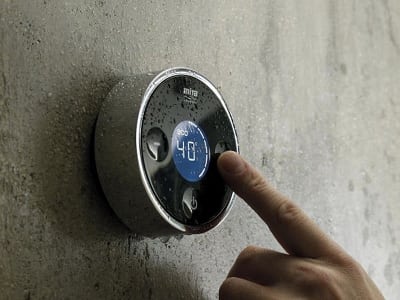Everyone is familiar with the quirks of their own shower. The over-sensitive hot tap, the loose cold tap, the faulty pressure grip of the shower head on its pole.
Some playing around with the shower mixer is normally needed to get it right before you hop in. Though, rather awkwardly, you have to reach through a water stream that is often too hot or freezing cold to adjust the temperature.
Even worse than this is trying to figure out someone else’s shower quirks as a guest, while the hosts wait impatiently to go next. Help may be at hand, however, as technology has given us a new range of shower options. Digital showers and thermostatic shower mixers give you more control over temperature and flow. Researching which one will suit your own space can be done at home by look at sites like eBay.
An app can’t wash you
There have been dozens of visionary novelists, film makers and artists who have predicted apocalyptic, futuristic worlds where not only do we have a gadget for everything, technology actually takes over out lives with a will of its own. Smart phones are full of applications that communicate with your computer, your car, your central heating and even your kitchen appliances. Prototypes of smart houses are out there. Alas, the act of washing is still led by you with technology making the morning ritual a little more fun.

How do they work?
The digital shower is not an entirely new concept given that some of the first models arrived on the market around 2001. The latest models come with an inbuilt digital interface, a backlit numerical display with a series of thermostat settings and, with some models, a remote control. So you can get your shower running at your perfect temperature and water pressure before you go near the cubicle. No more tap twisting with baited breath, waiting to be scalded. New digital shower models can also include a 360-degree rotating shower head as well as a ceiling-mounted rain shower above, which you can use the digital interface to switch between. You can also save your favourite settings.
Thermostatic showers use old-school engineering to ensure a steady and easily maintained flow of water at the right temperature. According to Horne, a company specialising in temperature control, thermostatic valves work via a central element that expands and contracts in response to changes in water temperature and pressure. So if the cold water fails, for example, the element would expand fully and block the incoming hot water valve so you do not get burnt. Clever in a Brunel if not Steve Jobs kind of way.

How much do they cost?
The digital series of showers are generally more expensive than their thermostatic counterparts, due to the relative complexity of the technology and design. Most digital models range between £200 and £700 when in new condition whereas the thermostatic prices rarely exceed £150. Costs are of course before installation though sellers occasionally provide self-installation instructions on the off chance that you fancy yourself competent enough to plumb and, in the case of the digital models, wire them into you bathroom yourself.












